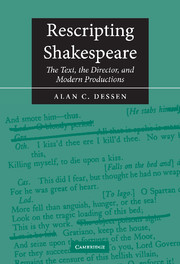Book contents
- Frontmatter
- Contents
- Acknowledgments
- Note on documentation
- List of abbreviations
- 1 “Let it be hid”: price tags, trade-offs, and economies
- 2 Rescripting Shakespeare's contemporaries
- 3 Adjustments and improvements
- 4 Inserting an intermission/interval
- 5 What's in an ending? Rescripting final scenes
- 6 Rescripting stage directions and actions
- 7 Compressing Henry VI
- 8 The tamings of the shrews: rescripting the First Folio
- 9 The editor as rescripter
- Conclusion: what's not here
- Appendix: productions cited
- Notes
- Index
8 - The tamings of the shrews: rescripting the First Folio
Published online by Cambridge University Press: 22 September 2009
- Frontmatter
- Contents
- Acknowledgments
- Note on documentation
- List of abbreviations
- 1 “Let it be hid”: price tags, trade-offs, and economies
- 2 Rescripting Shakespeare's contemporaries
- 3 Adjustments and improvements
- 4 Inserting an intermission/interval
- 5 What's in an ending? Rescripting final scenes
- 6 Rescripting stage directions and actions
- 7 Compressing Henry VI
- 8 The tamings of the shrews: rescripting the First Folio
- 9 The editor as rescripter
- Conclusion: what's not here
- Appendix: productions cited
- Notes
- Index
Summary
“They sit and mark”
The Taming of the Shrew, 1.1.254Any play in the Shakespeare canon is a candidate for rescripting or rewrighting, but a playgoer is most likely to encounter substantive alterations in a production of The Taming of the Shrew. A variety of reasons underlie such decisions. As might be expected, some elements in the Folio text (the role of Hortensio, the final couplet) are regularly adjusted or improved. More tellingly, the availability of additional Christopher Sly material in an alternative 1594 version of the taming story has provided an irresistible temptation for some directors. Perhaps most significant, discomfort with the Folio's final sequence, particularly Katherine's long speech and related stage business, has led to a wide variety of adjustments and some rewrighting. The goal of this chapter is to call attention to a range of in-the-theatre choices, to link those choices to an ongoing scholarly debate about rival texts, and to call attention to the price tags and trade-offs for such rescripting.
To start with some textual history, printed in 1594 and reprinted in two subsequent quartos (1596, 1607), The Taming of a Shrew (hereafter referred to as A Shrew or 1594) is the version of the Katherine story known to readers during the 1590s and early 1600s. Today's reader, however, is familiar with The Taming of the Shrew (hereafter referred to as The Shrew or 1623), the play as printed in the First Folio of 1623.
Information
- Type
- Chapter
- Information
- Rescripting ShakespeareThe Text, the Director, and Modern Productions, pp. 185 - 208Publisher: Cambridge University PressPrint publication year: 2002
